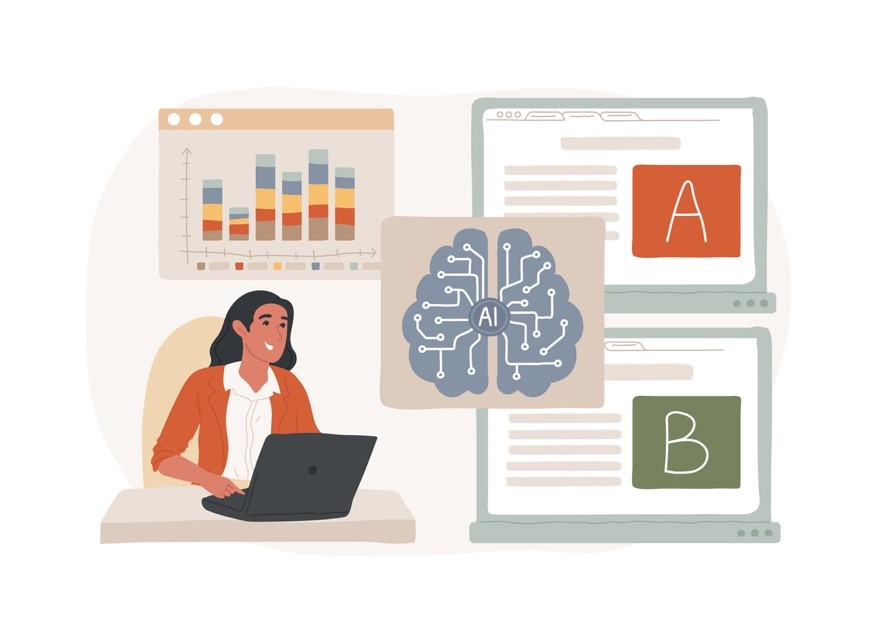Other articles in this series include:
Part 2: Navigating AI in K-12 Procurement: A Guide for School District Leadership
Part 3: Mastering AI Prompts: A Guide for School Administrators
Part 4: AI in Action: Best Tools for K-12 School Procurement Leaders
Part 5: AI-Powered Grant Writing: A Game-Changer for K-12 School Leaders
Artificial intelligence (AI) is rapidly transforming the landscape of school administration, moving beyond the classroom to reshape how educational institutions manage operations and streamline workflows. Drawing on recent research and surveys, this article explores the leading ways school leaders are leveraging AI to optimize school operations while highlighting the benefits, challenges, and emerging best practices in the field.
AI as a Strategic Partner in School Operations
A recent Rand Report found that 58% of K-12 school principals reported using AI tools for work during the 2023-24 school year. While many school leaders are starting to use AI in school operations, we are just scratching the surface in terms of the ways that AI can make our work more effective and efficient. By automating routine tasks, enabling data-driven decisions, and improving communication, AI empowers school leaders to focus on what matters most: supporting students, staff, and families.
While many teachers are experimenting with AI in the classroom, school administrators are in the early stages of figuring out how to effectively use AI in their daily work. This guide provides a step-by-step process for integrating AI effectively into school administrative work.
What is Generative AI?
To use AI it is helpful to have a general understanding of what it is and is not. Generative AI is a type of artificial intelligence that can create, or more accurately generate, original content from learned patterns. AI machines train on huge amounts of content including books, articles, images, and other resources. The machines are able to identify patterns and then respond to questions by giving the most probable responses to those questions based on billions of pieces of content.
Generative AI, referred to simply as AI, are also called Large Language Models (LLM). The following are some of the more popular LLMs currently in use:
- ChatGPT/GPT4
- Google’s Gemini
- Microsoft’s Bing Chat
- DALL-E
- Midjourney
- Claude
There are dozens of other LLMs available as well. Most have free and paid subscription models. These models are not to be confused with AI tools, also called AI wrappers. Think of wrappers as an app or layer of software that sits between the user and the AI model to manage specific interactions and make the AI easier to use for certain tasks. For example, Curipod is an app that uses AI to provide teachers with a way to instantly generate customized lesson plans for specific topics and learners. For more on Wrappers and Apps see: AI in Action: Best Tools for K-12 School Procurement Leaders

Make AI Your Intern not Your Colleague
AI is similar to having a new intern. You need to oversee its work and make sure it is not making mistakes or getting into trouble. Think of AI as an extension of you. For example, let’s say a principal in a California school district sends out a standard winter holiday letter to parents with the usual updates, vacation schedules, and good tidings. The principal writes a brief prompt instructing AI to use an engaging friendly style in writing the letter. AI provide a draft and does an excellent job, except that the AI draft encourages families to cross their fingers for snow so that everyone can enjoy outdoor skating and sledding… in California!
One of the pain points with an AI assistant is that it does not like to admit it doesn’t know something. When it is stumped in will make up content. Large language models are trained in a way that tends to reward producing an answer, even if the answer is not correct. While some AI tools can develop and learn, many need to be treated like an intern that needs to be continually checked up on. It’s one of the few downsides of a tool that can almost magically reduce your workload by automating your more tedious tasks and freeing you up to focus on more complex issues.

Implement AI Strategically
AI adoption can be disruptive. Start the implementation process by investing up front in training and change management to ensure staff buy-in to ensure a smooth transition. School administrators should provide professional development, communicate the benefits of AI, and address concerns around job security or data privacy.
After developing a good understanding of the benefits and shortcomings of embedding AI in daily school operations try piloting a few projects. Start small and build. Successful AI roll-outs focus on specific pain points such as clear operational challenges (e.g., streamlining enrollment, reducing absenteeism, or improving communication) and select AI tools that directly address these needs.
A plan of action for embedding AI in school operations might consist of the following:
- Identify High-Impact Areas: Start by mapping out administrative processes that are time-consuming, error-prone, or critical to school operations. Examples include attendance tracking, scheduling, communication, and data analysis.
- Research and Select AI Tools: Explore AI solutions tailored for education administration. Look for platforms that integrate with existing systems and offer user-friendly interfaces.
- Pilot and Gather Feedback: Implement AI tools in a controlled setting, gather feedback from users, and measure impact. Use insights to refine processes and build a case for broader adoption.
- Train Staff and Foster Buy-In: Invest in professional development to ensure staff are comfortable using AI tools. Highlight the benefits, such as time savings and improved decision-making, to encourage adoption.
- Monitor, Evaluate, and Iterate: Regularly review the performance of AI systems, solicit feedback, and adjust as needed. Stay informed about advances in AI to continually improve school operations.
Target Areas Where AI Can be of Greatest Benefit
The RAND study identified five areas where school principals found AI to be most useful:
Drafting communications to enhance writing
School leaders spend a great deal of time generating newsletters for parents, emails to staff, and generating policy documents. AI can assist with improving communications by personalizing messages to parents, staff, and other stakeholders, automating reminders for events or deadlines, and ensuring that critical information is delivered on time.
AI can be used to generate ideas and titles for newsletters and policy documents that school administrators can then edit for accuracy and tone. AI chatbots and virtual assistants can be set up to answer frequently asked questions, provide information about school events, and offer support 24/7, reducing the burden on front-office staff.
Support school administrator tasks
AI is particularly good at helping streamline administrative process. AI-powered systems can automate and track attendance, AI algorithms can help with scheduling by creating optimized timetables, balancing teacher availability, subject requirements, and student needs to minimize conflicts. AI is also useful for generating and drafting reports. Automated systems can compile and analyze data for reports, freeing administrators from tedious manual compilation and enabling real-time insights to assist school leaders in analyzing and making recommendations.
AI is also useful at generating ideas for administrative tasks such as generating a list of questions to ask on a parent survey or summarizing school data and needs for outlining and drafting RFPs. School leaders can identify repetitive and time-consuming tasks such as invoice processing and data entry. This reduces the load on staff while also reducing errors.
Some schools are now using AI systems to not only automate attendance but also flag at-risk students by analyzing trends in absenteeism, performance, or engagement. This early warning system allows administrators to intervene proactively, supporting student success and reducing dropout rates.
AI-powered dashboards and analytics platforms can also help school leaders visualize trends in resource utilization. These insights can help support evidence-based decision-making and long-term strategic planning.
Support teacher hiring, evaluation, and professional learning
Many areas of human resources such as the routine aspects of hiring and teacher and staff evaluation can be farmed out to AI tools. According to the RAND study, principles and other school administrators use AI to craft job descriptions, interview questions, hiring rubrics, or justifications for a position. AI is also used to support teacher evaluation and provide feedback. AI can create evaluation templates, summarize a collection of observational notes, and draft reports and improvement plans.
School leaders use AI to generate ideas for types of professional training their teachers and staff may need and to create training scenarios that can be used in professional development discussions. Administrators also use AI to draft meeting agendas and to take and summarize meeting minutes.
It is important to note that AI does not completely take over this type of work, but instead provides a starting point and completes the more routine and onerous parts of these processes. For example, a principal might create a training presentation and then have AI create an attractive slide deck to support their presentation.
Support instruction or demonstrate to teachers how to use AI for instruction
Because AI is being more quickly adopted for classroom activities, principals and other school administrators need to be up to speed on best uses for AI in the classroom and also be aware of any concerns with using AI in learning, such as student privacy or guarding against mistakes AI can make.
Fully understanding AI use in the classroom helps school leaders draft policy documents and school rules for students and teachers around using AI for classroom activities or completely homework assignments.
School leaders can be helpful in guiding teachers to use AI to create classroom activities and assessments and to personalize learning for each student. School administrators can also create professional learning activities for teachers so that teachers can find ways to help automate planning activities such as tracking standards, building IEP goals, and creating assessments.
Principals described using AI to generate classroom activities and assessments and to differentiate instruction. These principals also described the ways in which they helped teachers use AI for planning. For instance, principals described guiding teachers’ use of AI to support with lesson planning, unpacking standards, creating assessments, building IEP goals, and differentiating student resources.
Research topics relevant to their jobs
There is no end to the ways in which AI can be used to research any job-related activity where more information is needed. Like Google search, AI can be instructed to summarize specific topics or reports and keep up with events and policies relevant to K-12 schools, or analyze AI uses for school tasks.
Challenges in Using AI in School Operations
Despite the clear benefits, AI adoption in school administration and procurement comes with some significant challenges and concerns.
Data Privacy and Security
Safeguarding sensitive information is paramount, especially when using AI for data analysis and communication. The integration of artificial intelligence in schools introduces significant data privacy concerns. AI systems in education often require access to a wide range of sensitive student information, including academic records, behavioral data, biometric identifiers, and even images. This extensive data collection raises the risk of data breaches, where unauthorized parties could gain access to confidential student information, potentially leading to identity theft or misuse.
Another concern is data exploitation, where student data collected for educational purposes might be repurposed for marketing, research, or other non-educational activities without proper consent. Additionally, the constant surveillance enabled by AI tools can create an environment where students feel monitored, potentially stifling free expression and eroding trust in educational institutions.
To mitigate these concerns, schools must adopt robust data privacy strategies. Key measures include:
- Ensuring transparency in data collection and usage by clearly communicating policies to students and parents, and obtaining informed consent before gathering any personal information.
- Employing strong encryption techniques and data anonymization that can help protect student identities and reduce the risk of unauthorized access.
- Regular security audits and compliance with relevant privacy laws, such as FERPA, COPPA, and state regulations that are essential for maintaining high standards of data protection.
- Empowering users, students, and parents, to control their data, including options to review, delete, or modify information, can further strengthen privacy safeguards.
AI Can Amplify Existing Inequities and Provide Unreliable Information
All use of AI in schools must be regularly reviewed by key stakeholders. AI systems in education can introduce significant bias, often reflecting and amplifying existing inequities in schools. When algorithms are trained on historical data that already contains patterns of discrimination-such as racial, gender, or socioeconomic disparities-they can perpetuate or even worsen these biases. For example, predictive models used to identify “at-risk” students have been shown to disproportionately flag minority students, leading to fewer resources or opportunities for those groups.
Adaptive learning platforms may also fail to accommodate diverse learning styles or cultural backgrounds, further marginalizing certain students. This can result in a self-reinforcing cycle where students from underrepresented backgrounds face systemic disadvantages, potentially impacting their long-term educational and career trajectories.
Beyond bias, AI tools in schools can be unreliable, leading to disruptions and mistrust among students, teachers, and administrators. Unreliable AI detection systems have, for instance, wrongly flagged student work as AI-generated, causing students to face academic penalties. Such errors undermine confidence in both the technology and the fairness of school operations.
More generally, AI tools can malfunction or deliver inconsistent results, or incorrect answers. This can erode trust and create administrative burdens. To mitigate these risks, school leaders should invest in well-tested, transparent AI systems, conduct regular audits for bias and accuracy, and provide ongoing training for staff. Establishing clear oversight mechanisms and fostering open dialogue with students and families about AI use are also critical steps to ensure that these technologies serve to enhance, rather than hinder, educational equity and reliability.
Data Accuracy
The old adage: garbage in, garbage out, is certainly apt when using AI for data analysis. AI is only as effective as the data it processes. Schools need to prioritize accurate data collection and management, whether for attendance, performance, or resource allocation, to maximize the benefits of AI-driven insights.
While there are significant concerns that need to be addressed when implementing AI in school operations, careful and strategic roll-out of AI tools can mitigate these concerns and provide enormous efficiencies for carrying out K-12 school administrative work.
Note: This article used AI for research, outlining, and idea generation. It is based, in part, on information from the following sources:
1. Uneven Adoption of Artificial Intelligence Tools Among U.S. Teachers and Principals in the 2023–2024 School Year. RAND report by Julia H. Kaufman, Ashley Woo, Joshua Eagan, Sabrina Lee, Emma B. Kassan
2. The Impact of AI on School Administration and Management, blog post by TeachFlow.
3. Best AI Tools for School Administrators. Blog post, techreformers.com.
4. AI Has Taken Classrooms by Storm. School Operations Could Be Next. EdWeek. Mark Lieberman.

Leslie Stebbins is the director of Research4Ed. She has more than twenty-five years of experience in higher education and K-12 learning and instructional design. She has an M.Ed. from the Technology Innovation & Education Program at the Harvard Graduate School of Education and a Master’s in Library and Information Science from Simmons College.








